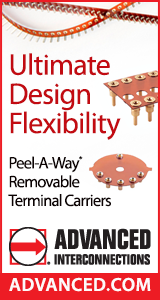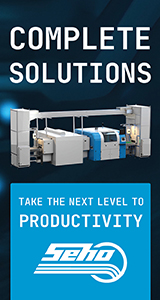|

|
|
| Ask the Experts | |||||||
|
|||||||
|
January 12, 2018 - Updated August 23, 2010 - Originally Posted Post Print Inspection IssueWe are using a post print inspection process. What do you recommend we do when we find defects in the solder paste print on the second side. We currently do not have an adequate cleaning process and scrap the boards when we find second side print defects. M. H. |
|||||||
| Expert Panel Responses | |||||||
|
Since you have no way of reworking defective boards, it is worth looking at optimizing the print and inspection processes. With second side printing board support, it is much more difficult to achieve and consequently gasketing can be a problem. This in turn can cause increased print defects. Without knowing how your paste inspection is setup, it is difficult to say much, but you can check that any limits are appropriate and track all failures to look for patterns that would suggest adjustments to the print process. It is known that about 80% of PCB functionality defects are due to poor solder paste printing. This is a critical part of any SMT assembly process and should have a good statistical control charting process to help minimize these defects. There are many inspection systems on the market that offer solutions for monitoring and analysis of solder paste processes. Some of these are even integrated into the Screen Printers. I would recommend looking into one of these Test Inspection systems. Additionally, there are 1-day training programs offered on interactive PCB inspection to improve inspection and observation skills.
Marketing 360-Biz Douglass Dixon is the Chief Marketing Officer for 360 BC Group, a marketing agency with offices throughout the US. 360 BC specializes in consulting and implementing successful marketing programs that utilize the latest in marketing, sales and technology strategies. As an electronics veteran, Dixon has worked in the industry for over 30 years for companies like Henkel, Universal Instruments, Camelot Systems, and Raytheon. Dixon's electronics industry experience includes a broad skill set that includes engineering, field service, applications, product management and marketing communications expertise.
Not a whole lot can be done without cleaning the misprint on the 2nd side; and for cleaning, an automated cleaning stepis recommended. Cleaning misprinted boardsmanually on the 1st or 2nd side is not recommended as:
Technical Manager - Europe Indium Corp. Currently with Indium Corporation and responsible for technology programs and technical support for customers in Europe. Over 15 yrs experience in SMT, Power, Thermal & Semiconductor Applications. Masters Degree in Industrial Engg, State University of New York-Binghamton.
Below is the feedback pertaining to question posed on the Circuitnet recently. The process requirements for double-side misprints differ only slightly from those used for regular PCBs, in which fluxes and solder paste residues are removed so that electrochemical migration, corrosion and lack of adhesion for coating materials is eliminated from the outset. Typically, the removal of printed paste does not present any critical problems. However, the concern is the soldered side wherein we have the components that are soldered having post-solder flux residues. An effective cleaning agent should not only be able to remove the solder paste residues but also be capable of easily remove the post-solder flux residues from the boards. Moreover, in order to increase the reproducibility of the cleaning results, an automated system such as industrial dishwasher type batch cleaner or conveyorized inline cleaning equipment (for high throughput) is recommended. Based on our past field experience, it would be recommended to clean the boards (depending on its complexity) in an equipment that can impart high pressure and can handle wash temperatures of about 120-140F using an alkaline cleaning agent. If you need further assistance in this matter do not hesitate to contact me.
Application Technology Manager Zestron America Mr. Tosun has published numerous technical articles. As an active member of the SMTA and IPC organizations, Mr. Tosun has presented a variety of papers and studies on topics such as "Lead-Free Cleaning" and "Climatic Reliability".
Scrapping out the misprint board is certainly a viable and sometimes cost saving alternative over cleaning them. Does labor cost and most importantly liability of the end product necessitate they be scrapped? As one example, a global manufacturer of automotive anti-lock brake controllers always scraps them out. They will not manually clean the tin-lead solder (EH&S prohibitive) or put them in the stencil washer. The inherent risk of a board failure in the field caused by a stray solder ball or three wreaking havoc under a component is too high. With that said if justified to clean the misprints you will have to set up a dedicated misprint cleaning station. How elaborate it is whether a manual soak station or a dedicated wash tool you will have to evaluate all options. Focus on the printer set up is important. Insure printer is properly serviced and most importantly the individuals are properly trained on the operation and set up of the printer. You may hear some comments from contract manufacturers that one misprint is one too many. If you need further assistance in this matter do not hesitate to contact me.
Technical Expert Sales Support Kyzen Corporation Charlie Pitarys has over thirty years of industry experience and has been with KYZEN for twenty-one years. Charlie is a former Marine and a retired Sargent First Class in the Army Reserves. His previous employers include Hollis and Electrovert. Charlie continues to use his expertise on cleaning processes and machine mechanics to help KYZEN customers and partners improve their cleaning operations.
Before cleaning double-sided or bare board misprints, I recommend you review the Stencil and Misprinted Board Cleaning Handbook (IPC-7526), the article by Richard Clouther, "SMT Stencil Cleaning: A Decision That Could Impact Production (Improving Screen Print Yields)" and my article, "Reducing the Cost of Misprinted PCBs." These and other resource articles may be downloaded from our website: http://www.smartsonic.com/
President Smart Sonic Corporation Mr. Schreiber developed the original ultrasonic stencil cleaning process in 1989. Obtained the only EPA Verification for specific parameters of Environmental Safety, User Safety and Cleaning Efficiency for a stencil cleaning process.
Search Google for misprint cleaners many different effective machines in the market so you don't have to scrap off the PCB. With the right Solvent Cleaner for fast drying while cleaning off the flux residues of the first side reflow.
Technical Sales Manager BLT Circuit Services Ltd Greg York has over thirty two years of service in Electronics industry. York has installed over 600 Lead Free Lines in Europe with Solder and flux systems as well as Technical Support on SMT lines and trouble shooting.
Obviously you will look into eliminating the root cause of the printing problems. If you have misprints however there are different avenues depending on:
Engineering and Operations Management Independent Consultant Georgian Simion is an independent consultant with 20+ years in electronics manufacturing engineering and operations.
Contact me at georgiansimion@yahoo.com. Reader Comment
Have you given any thought to using a waste PCB to tweek your printer setup then run your regular production? This way you wouldn't have to scrap boards and would have a setup board you can wash and reuse.
Mark Maheux, Honeywell, USA
|
|||||||
| Submit A Comment | |||||||
|
Comments are reviewed prior to posting. You must include your full name to have your comments posted. We will not post your email address. |
|
Free Newsletter Subscription
Circuitnet is built for professionals who bear the responsibility of looking ahead, imagining the future, and preparing for it. Insert Your Email Address |
|

|








